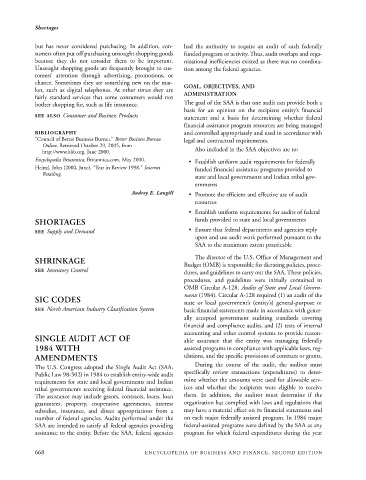Page 691 - Encyclopedia of Business and Finance
P. 691
eobf_S 7/5/06 3:21 PM Page 668
Shortages
but has never considered purchasing. In addition, con- had the authority to require an audit of each federally
sumers often put off purchasing unsought shopping goods funded program or activity. Thus, audit overlaps and orga-
because they do not consider them to be important. nizational inefficiencies existed as there was no coordina-
Unsought shopping goods are frequently brought to cus- tion among the federal agencies.
tomers’ attention through advertising, promotions, or
chance. Sometimes they are something new on the mar-
GOAL, OBJECTIVES, AND
ket, such as digital telephones. At other times they are
fairly standard services that some consumers would not ADMINISTRATION
bother shopping for, such as life insurance. The goal of the SAA is that one audit can provide both a
basis for an opinion on the recipient entity’s financial
SEE ALSO Consumer and Business Products statement and a basis for determining whether federal
financial assistance program resources are being managed
BIBLIOGRAPHY and controlled appropriately and used in accordance with
“Council of Better Business Bureau.” Better Business Bureau legal and contractual requirements.
Online. Retrieved October 29, 2005, from
http://www.bbb.org. June 2000. Also included in the SAA objectives are to:
Encyclopedia Britannica. Britannica.com. May 2000.
• Establish uniform audit requirements for federally
Heinzl, John (2000, June). “Year in Review 1998.” Internet funded financial assistance programs provided to
Retailing.
state and local governments and Indian tribal gov-
ernments
Audrey E. Langill • Promote the efficient and effective use of audit
resources
• Establish uniform requirements for audits of federal
SHORTAGES funds provided to state and local governments
SEE Supply and Demand • Ensure that federal departments and agencies reply
upon and use audit work performed pursuant to the
SAA to the maximum extent practicable
The director of the U.S. Office of Management and
SHRINKAGE
Budget (OMB) is responsible for dictating policies, proce-
SEE Inventory Control dures, and guidelines to carry out the SAA. These policies,
procedures, and guidelines were initially contained in
OMB Circular A-128, Audits of State and Local Govern-
ments (1984). Circular A-128 required (1) an audit of the
SIC CODES state or local government’s (entity’s) general-purpose or
SEE North American Industry Classification System basic financial statements made in accordance with gener-
ally accepted government auditing standards covering
financial and compliance audits, and (2) tests of internal
accounting and other control systems to provide reason-
SINGLE AUDIT ACT OF able assurance that the entity was managing federally
1984 WITH assisted programs in compliance with applicable laws, reg-
AMENDMENTS ulations, and the specific provisions of contracts or grants.
During the course of the audit, the auditor must
The U.S. Congress adopted the Single Audit Act (SAA;
specifically review transactions (expenditures) to deter-
Public Law 98-502) in 1984 to establish entity-wide audit
requirements for state and local governments and Indian mine whether the amounts were used for allowable serv-
tribal governments receiving federal financial assistance. ices and whether the recipients were eligible to receive
The assistance may include grants, contracts, loans, loan them. In addition, the auditor must determine if the
guarantees, property, cooperative agreements, interest organization has complied with laws and regulations that
subsidies, insurance, and direct appropriations from a may have a material effect on its financial statements and
number of federal agencies. Audits performed under the on each major federally assisted program. In 1984 major
SAA are intended to satisfy all federal agencies providing federal-assisted programs were defined by the SAA as any
assistance to the entity. Before the SAA, federal agencies program for which federal expenditures during the year
668 ENCYCLOPEDIA OF BUSINESS AND FINANCE, SECOND EDITION

